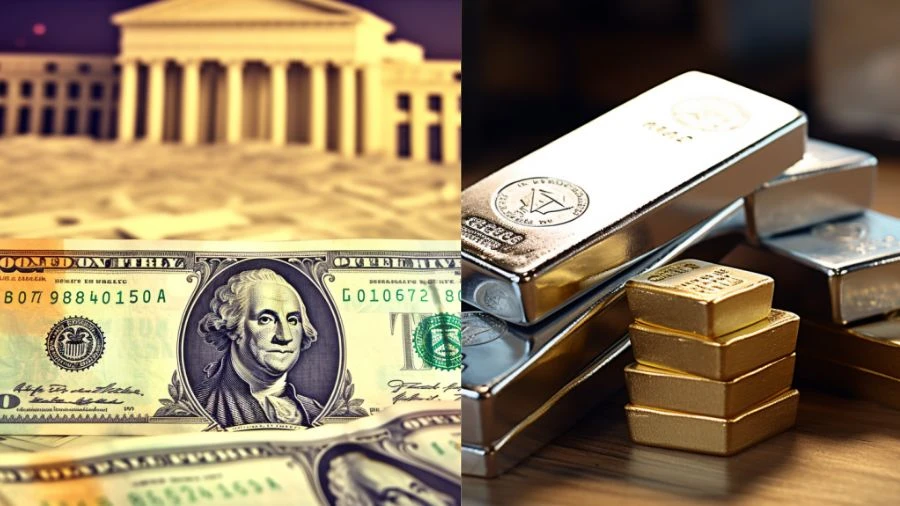
Fiat Money Vs Commodity Money, How Does Fiat Money Works?
Fiat money relies on trust in the issuing government and faces inflation risks due to its lack of intrinsic value, while commodity money, such as gold, possesses inherent worth but is susceptible to price fluctuations and debasement.
by Kowsalya
Published Nov 15, 2023 | Updated Nov 15, 2023 | 📖 9 min read
On This Page
Fiat Money Vs Commodity Money
Fiat money and commodity money represent distinct forms of currency with varying susceptibility to inflation. Fiat money derives its value from public trust in the issuing government, lacking intrinsic worth, and being vulnerable to inflation as it can be printed at will. In contrast, commodity money, such as gold or silver, possesses intrinsic value based on the material it is made from but faces inflation risks due to factors like debasement or fluctuations in commodity prices.
Debasement occurs when the metal content of coins diminishes, reducing their value. While commodity money can experience large price fluctuations, fiat money is linked to the stability of the issuing government and can lose value due to inflation or even become worthless in cases of hyperinflation, exemplified by the historical instance in Zimbabwe. The choice between fiat and commodity money involves navigating the trade-offs between intrinsic value and vulnerability to inflation.
What is Fiat Money?
Fiat money is a form of government-issued currency that lacks intrinsic value and is not backed by a physical commodity like gold or silver. Its value is derived from the trust and confidence in the government that issues it, as well as the relationship between supply and demand in the market. Unlike historical currencies backed by precious metals, fiat money is not redeemable for a specific commodity.
Instead, its value is sustained by the government's declaration that it is legal tender for private and public debts. While fiat money provides central banks with greater control over the economy and is cost-efficient to produce, it is not without risks. The potential for overproduction can lead to inflation or even hyperinflation, and its value relies heavily on the stability and credibility of the issuing government. Examples of fiat currencies include the U.S. dollar, the euro, and the Japanese yen.
How Does Fiat Money Works?
Fiat money operates on a unique economic principle, distinct from commodity-based currencies like gold or silver. Its functionality is rooted in the trust and confidence that individuals and institutions place in the government issuing the currency. The key aspects of how fiat money works are as follows:
- Government Decree: Fiat money is essentially a legal tender declared by a government. It has value because the government says it does, and people are obligated to accept it as a means of payment for goods, services, and debts.
- No Intrinsic Value: Unlike commodity money, such as gold, fiat money lacks intrinsic value. It is not backed by a physical commodity; instead, its worth is derived from the trust in the government's stability and its ability to manage the economy.
- Supply and Demand Dynamics: The value of fiat money is influenced by the relationship between its supply and demand. Central banks, authorized to issue fiat currency, have control over its production. Adjusting the money supply allows governments to manage economic variables such as interest rates, liquidity, and credit supply.
- Acceptance for Taxes: A crucial aspect of fiat money's value is that governments require citizens to pay taxes in the issued currency. This creates a perpetual demand for the currency, as individuals and businesses must obtain it to meet their tax obligations.
- Flexible Monetary Policy: Fiat money provides governments with the flexibility to implement monetary policies. Unlike fixed commodity standards, which can constrain a nation's ability to respond to economic fluctuations, fiat currency allows for adjustments to meet the evolving needs of the economy.
- Legal Tender Status: Governments declare fiat money as legal tender, making it the officially recognized currency for transactions. This legal status compels individuals and businesses to accept it as a form of payment and settles debts.
- Chartalism and Credit Theory: The value of fiat money is also supported by economic theories like chartalism, which emphasizes the importance of government acceptance, and credit theory, suggesting that the credit-debt relationship inherent in money contributes to its value.
What is Commodity Money?
Commodity money, such as gold or silver, holds intrinsic value beyond its role as a medium of exchange. Unlike fiat currency, which relies on trust, commodity money's worth is independent. Throughout history, items like gold, silver, tea, and seashells served as commodity money. However, challenges like perishability and transportability led to its decline. Even today, in regions facing economic crises, commodity money resurfaces.
Notably, gold remains a form of commodity money, held by central banks. Distinct from fiat money, which is government-backed, commodity money's value is tied to tangible assets. The historical evolution of commodity money influences investment choices, and while no longer a common currency, its principles impact diverse assets, including art and alternative investments.
Embark on a journey through the expansive universe of Finance by delving into the diverse and informative content offered at MarketsHost.
History of Fiat Money
Fiat money, a currency without intrinsic value, has a fascinating history marked by significant transitions. Before its emergence, currencies were often tied to precious metals like gold or silver. However, the advent of fiat money, detached from physical commodities, revolutionized the global monetary system. In the United States, for instance, the shift from the gold standard in 1971 marked a pivotal moment in the history of fiat money.
This transition meant that the U.S. dollar was no longer redeemable in gold, emphasizing the government's full faith and credit as the basis for its value. Such historical shifts highlight the dynamic nature of fiat money and its reliance on government stability.
The history of fiat money is also punctuated by cautionary tales, such as the hyperinflation crisis in Zimbabwe during the early 2000s. In this extreme case, the government's unrestrained printing of money led to a staggering loss of value, demonstrating the inherent risks associated with fiat currencies when not managed judiciously. Understanding the historical evolution of fiat money provides crucial insights into its advantages, disadvantages, and the delicate balance required for maintaining economic stability.
What Are the Advantages and Disadvantages of Fiat Money?
Advantages of Fiat Money
- Central Bank Control: Fiat money provides central banks with a powerful tool to control the money supply and implement monetary policies. This allows for adjustments in interest rates and money circulation, enabling central banks to manage inflation and stabilize the economy.
- Cost-Efficient Production: Fiat money is relatively inexpensive to produce compared to commodity money, such as gold or silver coins. This cost efficiency is advantageous for governments and central banks, as it reduces the overall expenses associated with currency production.
- Flexibility for Governments: Governments have the flexibility to respond to economic conditions by manipulating the money supply. Fiat money allows for the implementation of fiscal policies, such as deficit spending, which can stimulate economic growth during periods of recession.
- Adaptability to Economic Changes: Fiat money can easily adapt to changes in the economy. Central banks can issue or withdraw money to respond to fluctuations in economic activity, helping to maintain stability and prevent severe economic downturns.
- Promotes Price Stability: Through the control of money supply, central banks aim to achieve price stability by managing inflation. This stability provides a predictable economic environment, which is beneficial for businesses and consumers.
Disadvantages of Fiat Money
- Inflation Risk: One of the significant drawbacks of fiat money is the risk of inflation. If central banks print too much money, it can lead to an increase in the overall price levels, eroding the purchasing power of the currency and negatively impacting consumers.
- Lack of Intrinsic Value: Fiat money lacks intrinsic value; its value is derived from the trust people place in the government or authority issuing it. This makes it susceptible to a loss of value if confidence in the issuing authority diminishes.
- Vulnerability to Government Mismanagement: Fiat money systems are susceptible to mismanagement by governments or central banks. Poor economic policies, excessive money printing, or political instability can lead to currency devaluation and economic turmoil.
- Risk of Hyperinflation: In extreme cases, the overprinting of fiat money can lead to hyperinflation, where the value of the currency rapidly and uncontrollably decreases. This can have severe consequences for the economy, causing a loss of confidence in the currency.
- Subject to Counterfeiting: Fiat money, being paper or digital, is susceptible to counterfeiting. Governments and central banks must invest in security measures to prevent counterfeiting, adding to the overall cost of maintaining the currency.
What Are the Advantages and Disadvantages of Commodity Money?
Advantages of Commodity Money
- Intrinsic Value: Commodity money, such as gold or silver, has intrinsic value due to its utility in various applications. This inherent value makes commodity money more resistant to sudden and drastic changes in its worth compared to fiat money.
- Stability: Commodity money tends to be more stable in value over time. The limited supply of precious metals like gold can contribute to a more predictable and steady value, reducing the risks associated with inflation.
- Medium of Exchange: Commodity money can serve as an effective medium of exchange. Its durability and divisibility make it suitable for transactions, facilitating trade and commerce in a straightforward manner.
- Historical Trust: Throughout history, commodity money has been widely accepted due to its intrinsic value and historical precedent. This trust in the value of commodities can contribute to a more stable and enduring monetary system.
- Resistance to Government Manipulation: Since the value of commodity money is not solely dependent on government decisions or policies, it is less susceptible to manipulation. This can be an advantage in situations where there is a lack of trust in governmental institutions.
Disadvantages of Commodity Money
- Lack of Portability: Commodity money, especially precious metals like gold and silver, can be heavy and cumbersome, making it less practical for everyday transactions. This lack of portability can be a significant drawback in modern, fast-paced economies.
- Limited Supply: The limited supply of commodities like gold can create problems, especially in times of economic expansion. If the money supply does not grow with the economy, it can lead to deflation, which may hinder economic growth.
- Difficulty in Division: Dividing commodity money into smaller, precise units for everyday transactions can be challenging. This can complicate trade and make it less convenient compared to more divisible forms of money.
- Vulnerability to External Shocks: Commodity prices can be influenced by external factors such as changes in mining output or geopolitical events. These external shocks can impact the stability of commodity money, introducing an element of uncertainty.
- Subject to Hoarding: Since commodity money has intrinsic value beyond its use as a medium of exchange, there is a risk of hoarding. Individuals may choose to store large amounts of commodity money, reducing its circulation and potentially affecting economic activity.
- Prone to Fluctuations in Value: While commodity money can provide stability over the long term, its value can still fluctuate based on market conditions. These fluctuations may not always align with the needs of a growing and dynamic economy.
Fiat Money Vs Commodity Money - FAQs
1. What is the main difference between fiat money and commodity money?
The primary distinction lies in their backing. Fiat money has no intrinsic value and is based on trust in the issuing government, while commodity money, like gold or silver, possesses inherent value due to the material it is made from.
2. How does inflation impact fiat money and commodity money differently?
Fiat money is more susceptible to inflation as it can be printed at will, potentially leading to a loss of purchasing power.
3. What historical events illustrate the advantages and disadvantages of fiat money?
The abandonment of the gold standard in 1971 marked a crucial moment for fiat money, emphasizing government stability as the basis for its value.
4. Why does fiat money provide governments with greater flexibility?
Fiat money allows governments to respond dynamically to economic conditions.
5. What role does trust play in the value of fiat money?
Fiat money's value relies on the trust and confidence individuals and institutions place in the government that issues it.




